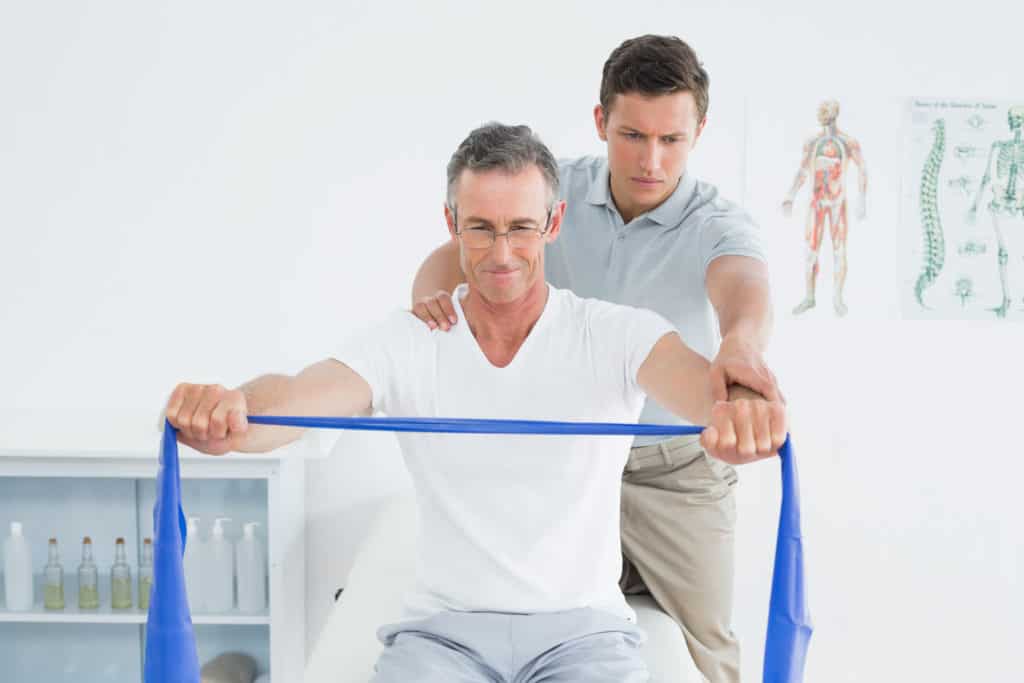
Is shoulder pain keeping you awake at night?
The shoulder joint has an extensive range of motion. You can move it up, down, back, forwards, and around in a 360-degree circle if you want to.
However, when an injury or damage to the bones or the surrounding muscles, ligaments, or connective tissue encases the joint occurs, it can impede the shoulder’s usual free movement and cause discomfort and pain.
But the “shoulder” isn't just one joint or bone. It's actually a ball and socket joint that is made up of three major bones a) the clavicle, b) the scapula, and c) the humerus – with an inner layer of cartilage.
Two primary joints connect these bones: the acromioclavicular joint and the glenohumeral joint (also referred to as the shoulder joint). The latter is exceptionally mobile and helps the shoulder move back and forth.
It also allows you to move your arm around in a circle and away from the body.
The “rotator cuff” – the group of muscles and four tendons surrounding the shoulder – is responsible for the shoulder’s impressive range of motion. The rotator cuff tendons attach the muscles to the bones.
But when these tendons suffer damage or inflammation, it can be challenging to move your arm.
The shoulder can suffer injury or damage through repetitive movement, sports, and manual labor.
In addition, many medical conditions can lead to pain in the shoulder. These include gallbladder disease, cervical spine issues, and heart and liver disease, to name but a few.
Generally, as we age, there is a greater risk of developing problems with the shoulder, especially after 60 years of age.
The main reason for this increased risk is due to the aging process, where wear and tear causes the shoulder’s soft tissues to "wear and tear."
While in most cases, you can reduce the level of degeneration inside the shoulder with a healthy, active lifestyle.
Occasionally, arthritis can develop in the bones and joints inside the shoulder, which may require pain medication or surgery (in severe cases).
However, in our experience, regular physical therapy is the best way to prevent and treat arthritis.
There are many different causes of shoulder pain. This blog looks at prevention, diagnosis, causes, and how best to treat shoulder pain.
What Causes Shoulder Pain?

Many medical conditions and different causative factors to do with your job or lifestyle can lead to shoulder pain.
Of these, the most common cause of shoulder pain that we see in the Apex Physical Therapy clinic is rotator cuff tendinitis.
When you suffer from rotator cuff tendinitis, the rotator cuff tendons surrounding and supporting the shoulder become swollen and inflamed.
Another reason for the shoulder pain we see regularly is "impingement syndrome," where the rotator cuff gets stuck between the acromion and humeral head (shoulder bones).
But it's not always just the shoulder joint. In some cases, shoulder pain can result from injury to another part of the body, like the biceps, neck, and cervical spine. We call this type of pain referred pain.
However, an excellent well to tell the difference is that referred pain is unlikely to worsen when you move the shoulder.
Some other reasons for shoulder pain are:
How We Diagnose Shoulder Pain

As physical therapists, we always determine the root cause of your pain rather than just treating symptoms. To do this, we evaluate your medical history and conduct a physical exam.
Depending on your symptoms, we'll look for any swelling, tenderness, and other signs of inflammation. In addition, we check the stability of your joints and range of motion.
We may also recommend specific imaging tests like an MRI, Cat Scan, or X-ray to confirm what we suspect is causing your pain.
Some of the questions we may ask you at the initial exam include:
The Best Treatments For Shoulder Pain

The treatment for shoulder pain depends on the severity and the root cause of the pain. But various treatment options are available to treat shoulder pain, including occupational therapy, physical therapy, and wearing supportive devices like a sling or shoulder strap.
If your shoulder pain is mild. You can usually manage it at home – with adequate rest, avoiding strenuous movements, and using heat/cold therapy to relieve pain and reduce inflammation. However, never apply heat or ice directly to your skin. Instead, use a towel or an ice bag.
Surgery is only ever necessary in really severe cases, where the pain is chronic, affects your quality of life, and has not responded to more conservative treatment.
Doctors usually prescribe medications like corticosteroids or non-steroid anti-inflammatories (NSAIDs). But we would urge you to avoid these and only take them if it is absolutely necessary due to the long-term health effects.
Physical therapy and lifestyle changes effectively take the place of these drugs.
But regardless of whether your shoulder pain is mild, moderate, or severe. We always recommend that you come and see us for a proper diagnosis rather than ignoring it and hoping it'll go away.
Things can and do get a lot worse if you don't seek treatment for chronic pain. On the other hand, if we catch it early enough – before any permanent damage occurs.
We can prevent things from getting much more painful, so it's not worth taking the risk and hoping for the best.
In most cases, there is a simple reason why you have shoulder pain that we can fix in a few sessions and educate you on how to prevent it from reoccurring. Hence, you never have to suffer from shoulder pain again.
How To Prevent Shoulder Pain

Some simple exercises for the shoulder can help you to limber up and strengthen the tendons and muscles of the rotator cuff.
But we recommend you consult a physical therapist to learn how to do these exercises. Then, we can guide you on performing the movements and exercises correctly – without risking further injury.
The exercises we recommend also depend on the root cause of your shoulder pain. For example, if you have tendonitis or bursitis, you should practice specific range of motion exercises daily to prevent frozen shoulder syndrome.
You can do other things to prevent shoulder pain, including building your shoulder strength with resistance training. Or changing your sleeping position to sleep on the opposite side of your back.
But we can advise you on the best changes to make depending on the root cause of your shoulder pain.
Book your free consultation now to find out how we can help you identify and fix the source of your shoulder pain.
-
*Please note that if there is no previous injury. Your shoulder pain is severe and comes on suddenly for no plausible reason, you should contact a doctor immediately, as it could be because of a heart attack.
Some of the other signs and symptoms of a heart attack are:
In case of any traumatic injury to the shoulder, if there is swelling, bleeding, or exposed tissue, we also recommend that you visit the emergency room as soon as possible.


